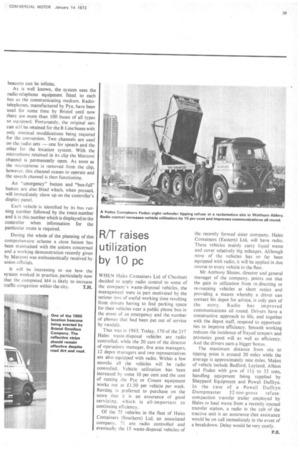Bristol uses beacons
Page 40

Page 41

If you've noticed an error in this article please click here to report it so we can fix it.
THE Bristol-Marconi B-Line bus location system, which will provide a means of controlling Bristol buses from a central point, using radio-telephony as the link, has taken another significant step forward towards its pilot introduction in May with the delivery recently from Marconi, of Chelmsford, of the first modified and fully equipped RELL bus. At the same time, the erection of some 1800 roadside beacons is well on its way while at the control centre of the operation in the city centre the wiring link-up for the installation of the PDP 8 computer has been completed.
The 2ft 6in. tall beacons are mounted on convenient posts along each of the four initial bus routes to be used, at intervals of 10 to the mile outside the city limits and 20 to the mile inside limits. The bottom of the beacons are 8ft 3in. above the ground level and so are well out of reach of the "British standard" vandal.
Experience has shown that the reflective strips, even when virtually obliterated by mud and dirt and invisible to the naked eye, will still reflect the Laser light emitted from the side of the bus. The positioning of the strips on the beacons to indicate their location is based on a binary code so that for all practical purposes the number of
beacons can be infinite.
As is well known, the system uses the radio-telephone equipment fitted to each bus as the communicating medium. Radiotelephones, manufactured by Pye, have been used for some time by Bristol until now there are more than 100 buses of all types so equipped. Fortunately, the original sets can still be retained for the B-Line buses with only minimal modifications being required for the conversion. Two channels are used on the radio sets — one for speech and the other for the location system. With the microphone retained in its clip the Marconi channel is permanently open. As soon as the microphone is removed from the clip, however, this channel ceases to operate and the speech channel is then functioning.
An "emergency" button and "bus-full" button are also fitted which, when pressed, will immediately show up on the controller's display panel.
Each vehicle is identified by its bus running number followed by the route number and it is this number which is displayed to the controller when information for the particular route is required.
During the whole of the planning of this comprehensive scheme a close liaison has been maintained with the unions concerned and a working demonstration recently given by Marconi was enthusiastically received by union officials.
It will be interesting to see how the system worked in practice, particularly now that the completed M4 is likely to increase traffic congestion within the city. T.H.
















































































































